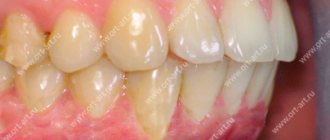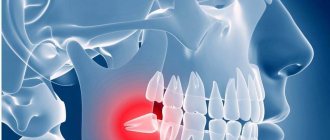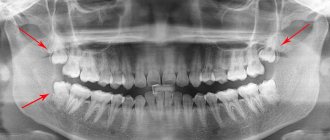- When is it necessary to remove the lower wisdom tooth?
- Tooth eruption problems. Wisdom teeth removal in advance
- Indications and contraindications
- Preparation for the procedure
- Removal steps
- Possible complications after removal
- Time and prices for the procedure
- Advantages of treatment at Aurora
Removal of a wisdom tooth on the lower jaw
Most people of conscious age go to the dentist because of problems with their lower wisdom teeth.
They often interfere, put pressure on neighboring molars, and cause discomfort or pain after eating. Most often, wisdom teeth in the lower jaw appear between the ages of 20 and 25, although the timing varies from person to person; for some, they may appear at the age of 16, for others closer to 40 years. In most cases, the appearance of figure eights is accompanied by various complications that require their removal. Malocclusion, difficulty in teething, tumors and trauma to the mucous membrane and much more.
Prevention
As you know, it is easier to prevent a disease than to treat it. The main disease prevention measures are:
- annual dental examinations;
- timely diagnosis and treatment of impacted molars;
- maintaining oral hygiene;
- timely treatment of caries, gingivitis, periodontitis and other dental diseases;
- Regular (once every six months) professional teeth cleaning in a dental clinic.
Remember: pericoronitis without proper treatment can cause very serious complications. Therefore, if you suspect inflammation, do not delay your visit to the dentist. The doctor will help you cope with unpleasant sensations in a matter of days and prevent the development of the disease.
When is it necessary to remove the lower wisdom tooth?
Eighth teeth are removed in two cases: when they have not yet sprouted or are already protruding from the gums. In the first case, the operation is performed if the patient feels discomfort, and during an external examination the doctor does not see diseased teeth. The appearance of pain means that the molar in the gum is pressing on its neighbor and disturbing him.
If the wisdom tooth has erupted incorrectly - that is, not straight up, but with a deviation, at an angle to the jaw and neighboring teeth, then removal is also a mandatory procedure. The slope of the figure eight is:
- distal - when the “eight” is tilted back, away from the “seven”. In this case, there is a risk of injury to the gums and damage to the roots of the adjacent tooth;
- medial - when the “eight”, on the contrary, is inclined towards the neighboring tooth. This increases the likelihood of damage to the crown part of the “seven” and the development of caries on both teeth;
- buccal – in this case, the wisdom tooth is turned towards the cheek and constantly touches the mucous membrane, causing irritation and hardening of the tissues. This condition can eventually lead to the formation of a tumor on the mucosa.
The removal of a wisdom tooth in the lower jaw is definitely necessary in the following cases:
- Caries on a wisdom tooth.
- Lack of space in the row for teeth. The last molars put pressure and cause discomfort.
- Pain in the gum where the wisdom tooth is located, at any time of the day, even after sleep.
- Incorrect growth sideways towards the tongue or larynx. This phenomenon is called dystopia.
- It interferes with implantation.
A tooth can erupt without causing pain once it appears; it will still be removed because it is not growing properly. The dentist makes an accurate diagnosis. To make an appointment, leave a request on the website or call one of the numbers: +7-924-444-05-45 - administrator
Removing a wisdom tooth in the lower jaw is a more complex procedure than removing an upper tooth. The bottom eights have a more powerful root system, and the jaw bones are denser and thicker. To remove a lower molar, it is necessary to perform a complex operation with dissection of the gum. In some cases, the surgeon has to remove part of the bone, divide the root into several parts and extract them separately.
Sign up for a free consultation
Tooth eruption problems. Wisdom tooth removal in advance
Many patients think that if the wisdom tooth is not visible on the gum, then there is no need to worry. However, over time, this molar increases in size and begins to interfere with the others. Waiting until the wisdom molar appears can lead to the following problems:
- pain in the tooth and gum;
- caries between molars;
- curvature of the roots of a healthy chewing tooth;
- infection in the place where the molar erupts because it grows incorrectly;
- curvature of the bite.
It is easier for a doctor to pick up and remove a tooth that has not yet come out. So while there is no pain, it is better to have surgery in advance.
Content:
- Peculiarities
- Indications
- Contraindications
- Operation
- Removal methods
- Difficult removal
- Stages
- Diagnostic value
- Does it hurt to remove
- Possible complications
Wisdom teeth or “eight” teeth, located at the edges of the jaw, erupt much later than their counterparts. Moreover, this often happens in adulthood, causing a person many unpleasant moments. The fact is that the structure of the human jaw does not provide enough free space to comfortably accommodate an additional pair of teeth. Therefore, “eights” often put pressure on “sevens”, they grow at an angle, their roots become curved, and it can be difficult to provide them with proper hygienic care, as a result of which caries develops. The peculiarities of the location do not allow for high-quality treatment of the wisdom tooth, and the optimal solution is its removal, since it bears neither a functional nor an aesthetic load.
Indications and contraindications
The attending physician (therapist) or orthodontist directs the removal of a molar in the lower jaw. In any case, the patient is sent for a panoramic photo, where the location of the teeth is visible. This procedure facilitates the work of the surgeon who has to deal with a complex operation. Contraindications for removal are as follows:
- Pregnancy and breastfeeding. After such a complex removal, the mother will have to stop breastfeeding, because antibiotics and painkillers can get into the baby along with the milk.
- People of the older generation with a diseased heart, hypertension of the 2nd or 3rd degree should be attentive to their health and not rush into surgery, but it is better to refuse it altogether.
- Malignant formation in the tooth growth zone.
Tooth extraction is also done as a preventive measure in advance, so that later they do not hurt and do not interfere with others.
Preparation for the procedure
Before removing a tooth, it is necessary to undergo a computed tomogram (CT ). The device allows you to illuminate the teeth and see the location of the crowns and roots in the gums. CT will make the surgeon’s work easier and save him from a long and complex operation. The procedure is painless. Done quickly.
The choice of tooth extraction technique depends on several factors:
- the presence or absence of inflammation of the soft tissues surrounding the tooth,
- duration of the process,
- location of the third molar in the bone,
- contacting a doctor during periods of exacerbation or remission of the disease,
- degree of tooth crown destruction.
Removal steps
The procedure can be divided into three stages:
- preparatory;
- The operation itself;
- After surgery.
Preparatory stage.
At this stage, the doctor visually examines the patient's oral cavity. Then a computed tomography is done to look at the length and shape of the roots, the depth of the tooth, etc.
Surgery
Complex wisdom tooth removal is divided into several stages. Let's consider a generalized operation scheme:
- A painkiller is given. To do this, a needle is inserted into the lower jaw to the nerve bundle so that the patient does not feel pain. Lips, chin, tongue are numbed. If sensitivity does not disappear, an additional injection is given. After anesthesia, the course of a complex extraction procedure depends on the location of the tooth.
- An incision is made with a scalpel.
- The tooth is sawed down to make it easier to remove.
- Take out the crown and roots.
- The wound is treated and sutured.
This completes the surgical stage.
Postoperative stage
This stage is very important, its duration is 7 – 10 days. During this period, the surgical wound heals, and a clot first forms in the hole and then resolves. Patients must follow our doctor's instructions exactly to avoid post-operative complications.
Tooth extraction: how long does the procedure take?
With a simple type of extraction, the procedure is carried out in 10 - 20 minutes. The process of complex removal lasts from 30 minutes or longer, depending on the specifics of the operation. For example, removing a horizontal tooth can take up to 2 hours or more. At the same time, sometimes additional preparatory procedures are necessary, which also take time.
After tooth extraction in the lower jaw antibiotics to prevent the entry and spread of infection. Such complex manipulations are contraindicated for pregnant and nursing mothers. Painkillers are prescribed to reduce pain after the procedure.
For complex removal, the patient is asked to come back again in five days or earlier if a fever appears. If the tooth has come out halfway (semi-retinated tooth), removal is carried out in the same way, but it is easier to pull it out, since part of the molar is on the surface.
Anesthesia
Before the operation, complete anesthesia of the required area of the jaw is carried out. The most commonly used is local anesthesia, which is carried out using a carpule syringe and an anesthetic. Anesthesia of the lower jaw occurs 8-10 minutes after the injection. The duration of the analgesic effect depends on the drug used and is 2-4 hours. The operation itself is completely painless, but after the anesthetic wears off, the patient begins to feel pain. Therefore, after the procedure, the specialist gives prescriptions about the need to use medications (painkillers, anti-inflammatory, antimicrobial agents).
Possible complications after removal
Complications after surgery arise due to violations of doctors’ recommendations. Patients begin to rinse their mouth, go to the bathhouse, play sports, or do not take medications that were prescribed. It is absolutely IMPOSSIBLE to do this for 5 days, because the place where the tooth was located is easily inflamed. Pain after removal is normal. Because the anesthesia wears off and the gums heal. Taking painkillers reduces pain.
Without taking antibiotics, inflammation and suppuration may begin. This situation arises due to the fact that food often accumulates at the end of the gums, which is difficult to remove with a brush, and along with it remain microbes that cause suppuration.
If bleeding occurs after removal, you should press the wound with a cotton pad for 15 minutes. If the bleeding does not stop, you should consult a doctor.
For reference! For high-quality and rapid healing, it is necessary that the wound heals well, so you should not eat hard food for at least 5 days and clean the hole.
Time and prices for the procedure
This complex operation takes about an hour. The duration of the procedure depends on the complexity of the figure eight position and the degree of neglect.
The consultation is free of charge. The final cost can be found out after consulting a specialist.
| Name of service | Unit | Price |
| Primary appointment (examination, consultation) with a dental surgeon | units | 0 |
| Repeated appointment (examination, consultation) with a dental surgeon | units | 500 |
| Complex tooth extraction with root separation | units | 7000 |
| Removal of periodontitis tooth | units | 2000 |
| Removal of a permanent tooth | units | 4000 |
| Flap surgery in the oral cavity in the area of the 1st tooth | units | 2000 |
| Flap surgery in the oral cavity on periodontal tissues (convet flap displacement) | units | 6000 |
| Removing stitches | units | 200 |
| Suturing the oral mucosa | units | 500 |
| The operation of removing an impacted, dystopic or supernumerary tooth | units | 8000 |
| Stopping alveolar bleeding without suturing using hemostatic materials | units | 500 |
A detailed price list can be found on the website.
Rinse
Special rinses will help relieve pain and swelling at home. However, such treatment is symptomatic. If inflammation progresses, in no case should you limit yourself to rinsing only.
The treatment for inflammation recommended by dentists is ASEPTA Active mouth rinse. This unique two-component product with a combination of “chlorhexidine + benzydamine” has an antimicrobial, anti-inflammatory effect and provides an immediate analgesic effect.
To eliminate inflammation and relieve discomfort during wisdom tooth pericoronitis, it is possible to use such medicinal herbs as:
- chamomile;
- sage;
- calendula.
Make an appointment for lower wisdom tooth removal
Byshlyaga Dmitry Yurievich
Byshlyaga Dmitry Yurievich Orthopedic dentist
Extensive practical experience. Regularly undergoes internships and advanced training courses.
Working hours: from 9.00 to 20.00, daily, seven days a week, by appointment
Make an appointment
More details
Asatryan Alexander Aramovich
Asatryan Alexander Aramovich Dentist therapist - orthopedist - surgeon
Extensive practical experience. Regularly undergoes internships and advanced training courses.
Working hours: from 9.00 to 20.00, daily, seven days a week, by appointment
Make an appointment
More details
×
Clinical researches
Repeated clinical studies have proven that the two-component mouth rinse ASEPTA ACTIVE more effectively combats the causes of inflammation and bleeding compared to single-component rinses - it reduces inflammation by 41% and reduces bleeding gums by 43%.
Sources:
- The role of anti-inflammatory rinse in the treatment of periodontal diseases (L.Yu. Orekhova, A.A. Leontyev, S.B. Ulitovsky) L.Yu. OREKHOVA, Doctor of Medical Sciences, Prof., Head of Department; A.A. LEONTIEV, dentist; S.B. ULITOVSKY, Doctor of Medical Sciences, Prof. Department of Therapeutic Dentistry of St. Petersburg State Medical University named after. acad. I. P. Pavlova
- The role of hygiene products in the treatment of periodontal diseases (S.B. Ulitovsky Honored Doctor of the Russian Federation, Honored Dentist StAR Prof., Doctor of Medical Sciences, Department of Preventive Dentistry of Pavlov Pavlov State Medical University, St. Petersburg) S.B. Ulitovsky - Honored Doctor of the Russian Federation, Honored Dentist of StAR, Prof., Doctor of Medical Sciences; E.S. Alekseeva - associate professor, candidate of medical sciences; A.A. Vasyanina - associate professor, candidate of medical sciences; V.A. Grigoriev - Associate Professor, Ph.D.
- The use of drugs from the Asepta line in the complex treatment of inflammatory periodontal diseases (N.V. Berezina E.N. Silantyeva S.M. Krivonos, Kazan State Medical Academy. Kazan.) N.V. BEREZINA, E.N. SILANTIEVA, S.M. KRIVONOS Kazan State Medical Academy
Advantages of treatment at Aurora
Removing the lower wisdom tooth is a complex procedure that requires high specialist competence. Due to the inconvenient location and improper growth of the last molar, neighboring teeth suffer. Highly qualified specialists of our center easily and quickly carry out complex operations of this level. In addition, Aurora dentistry has other important advantages over its competitors:
- the possibility of receiving installments from Pochtabank or Renaissance Credit;
- individual approach;
- work on weekends, including for residents of the region by appointment;
- The doctor is assisted by an assistant, which allows him to carry out manipulations 2 times faster;
- modern, 100% high quality, imported materials.
Our dentistry offers the following promotions for the removal of the lower wisdom tooth:
- If you found out about us through 2GIS, we provide 5% on services;
- 10% discount on your birthday and the next 3 days
- For pensioners there is a “Golden Watch” promotion - a 10% discount on tooth extraction from 9-00 to 11-00
If you need complex and long-term dental treatment in Blagoveshchensk, we have an individual discount policy and a flexible payment schedule
To make an appointment, just call. On the appointed day, the doctor will see the patient and tell him how the lower wisdom tooth will be removed without pain after the procedure and fear.











